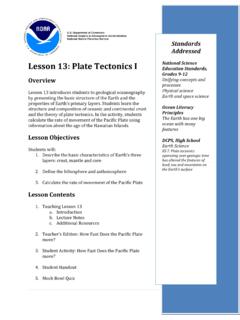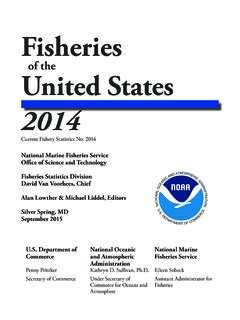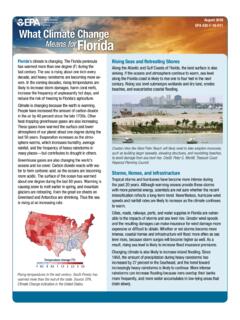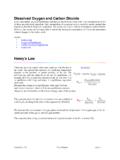Transcription of Lesson 3: Ocean Acidification National Science
1 1 | P a g e Lesson 3: Ocean Acidification Overview Lesson 3 describes the Ocean as a carbon sink that absorbs atmospheric carbon. Students read evidence that increasing carbon dioxide (CO2) levels in the Ocean are correlated with decreasing Ocean pH. In the activity, students develop and test a hypothesis about how acidic solutions affect calcium carbonate, which forms shells. Students explain the connection between Ocean Acidification and shell-building organisms including corals. Lesson Objectives Students will: 1. Describe human activities that increase carbon in the atmosphere 2. Describe the relationship between dissolved carbon dioxide and Ocean pH 3. Explain how Ocean Acidification affects marine life Lesson Contents 1. Teaching Lesson 3 a. Introduction b. Lecture Notes c. Additional Resources 2. Teacher s Edition: Ocean Acidification 3.
2 Student Activity: Ocean Acidification 4. Student Handout 5. Mock Bowl Quiz Standards Addressed National Science Education Standards, Grades 9-12 Unifying concepts and processes Science as inquiry Physical Science Earth and space Science Science in personal and social perspectives Ocean Literacy Principles The Ocean and humans are inextricably interconnected DCPS, High School Chemistry Write equations that describe chemical changes and reactions Define pH as the negative of the logarithm of the hydrogen (hydronium) ion concentration, and calculate pH from concentration data. Environmental Science Analyze situations and solve problems that require combining concepts from more than one topic area of Science and applying these concepts. Understand and explain that human beings are part of Earth s ecosystems, and that human activities can deliberately or inadvertently alter ecosystems.
3 2 | P a g e Teaching Lesson 3 Lesson 3 Lesson Outline1 I. Introduction Introduce the material by asking your students to guess which elements from the periodic table are found in the Ocean and to give a few examples. They may be surprised to know that the Ocean contains almost all of the elements. The major components (from greatest to smallest component) of seawater are2: Hydrogen Oxygen Chlorine Sodium Magnesium Sulfate Calcium Potassium Other minor components are: Bromine Boron Carbon Nitrogen Strontium Silicon Some trace elements (found at less than ) include: Phosphorus Argon Zinc Rubidium II. Lecture Notes Use the PowerPoint for Lesson 3 (File: Lesson 3 Ocean ) to present the following information. Save the wrap-up slides for after the activity is complete. Distribute the Student Handout before you begin for students to take notes on key information.
4 The Ocean is a carbon sink (slide 3) 1. A carbon sink is a natural or manmade reservoir that accumulates and stores some carbon-containing chemical compound for an indefinite period. 1 Unless otherwise indicated, all websites provided and referenced in this guide were last accessed in November 2010. 2 Turekian, K. Oceans. 1988. Prentice-Hall, New Jersey. 149pp. 3 | P a g e Teaching Lesson 3 Lesson 3 Teaching Lesson 3 Lesson 3 2. The Ocean is the largest natural carbon sink on Earth. How does the Ocean sequester carbon? (slide 3) 1. Carbon sequestration refers to the storage of carbon for indefinite time. 2. Carbon dioxide is dissolved into the Ocean surface from the atmosphere and then moved to the deep Ocean through physical processes and biological processes. Carbon dioxide in the Ocean (slide 5) 1.
5 Some marine organisms use carbon dioxide to live. Carbon dioxide is taken up by marine plants and algae during photosynthesis. 2. When carbon dioxide dissolves in seawater, most of it becomes bicarbonate ions and hydrogen ions. This increase in hydrogen ions is what decreases the pH. In addition, some of the hydrogen combines with carbonate to form more bicarbonate, decreasing the concentration of carbonate in seawater. Many marine organisms use carbonate, combined with calcium, to form their exoskeletons, shells or other structures ( corals). Humans affect the amount of carbon dioxide in the Ocean (slide 7) 1. Carbon dioxide in the atmosphere has been increasing since industrial times because of use of energy in homes, burning of fossil fuels for industry, emissions from transportation, cement manufacturing and deforestation. 2. Evidence indicates that pH in the oceans has decreased over the same time period.
6 Wrap-up: How can Ocean Acidification affect marine life? (slides 10-12) 1. Breaking down exoskeletons and shells. Evidence shows that some shelled organisms build shells more slowly, and some shells weaken and dissolve in acidic environments. 2. Increased acidity can lead to coral reef decline. 3. Some scientists are concerned that increased acidity might interfere with marine mammal communication. Evidence indicates that sound can travel further in the increasingly acidic Ocean , resulting in a louder environment that could confuse marine mammals3. III. Additional Web Resources 1. Background information 3 Hester, KC et al. 2008. Unanticipated consequences of Ocean Acidification : A noisier Ocean at lower pH. Geophysical Research Letters 35: L19601. 4 | P a g e Teacher s Edition Lesson 3 Ocean Acidification The original source of the activity for this Lesson is the SMILE Program at Oregon State University.
7 This Lesson , titled Dissolving Issues: Ocean Acidification , was adapted with permission by SMILE. The original Lesson can be found at the link below: ~doverl/SMILE/STW08/Activity%204%20 Dissolving%20 Issues/ Overview: Part I walks students through an exercise explaining why increasing atmospheric CO2 affects Ocean pH. Part II is an optional hands-on activity or demonstration for students to test the effect of increased acidity on calcium carbonate. Answer Key Part I: Use of CO2 in the oceans As you know, CO2 from the atmosphere dissolves into seawater. Let s look at this process in more detail: First, CO2 reacts with water to form carbonic acid (H2CO3-): (1) CO2 + H2O H2CO3- Carbonic acid can then dissociate into bicarbonate (HCO3-): (2) H2CO3- H+ + HCO3- Bicarbonate can then dissociate into carbonate ions (CO32-) (3) HCO3- H+ + CO32- There are two very important biological and chemical processes that are dependent upon the above compounds.
8 First, some marine organisms use carbonate to form calcium carbonate (CaCO3). Can you list two examples of vital uses of calcium carbonate to marine life? Possible answers: Shell formation, exoskeleton formation, coral reef formation Second, carbonate ions regulate the pH of seawater. If an acid is added to seawater, the carbonate ion reacts with excess hydrogen ions to produce bicarbonate (see equation 2). If a base is added to seawater, this bicarbonate will donate hydrogen ions to neutralize the base. (4) 2CO32- + H2SO4 (an example of an acid) 2 HCO3- (bicarbonate) + SO42- 5 | P a g e Teacher s Edition Lesson 3 Questions for Part I 1. The above reactions are all reversible, meaning that a chemical change can cause them to occur in the opposite direction.
9 A. Write the reverse reaction of equation (3). CO32- + H+ HCO3- b. Thinking about your answer from question (a), if excess CO2 results in an excess of hydrogen ions in seawater what will happen to carbonate? Some of the excess Hydrogen ions will combine with carbonate to form bicarbonate therefore reducing the availability of carbonate to marine organisms. c. What effects do you think this could have on the formation of skeletal structures for marine life? Shells, corals and exoskeletons may break down or corrode. Teacher Notes: Common misconceptions First recall the initial equations presented above representing the chemical reactions that follow when CO2 dissolves in seawater. (1) CO2 + H2O H2CO3- (2) H2CO3- H+ + HCO3- (3) HCO3- H+ + CO32- When first viewing these equations it may appear that both hydrogen ions and carbonate ions increase in solutions as a result of CO2dissolving in seawater.
10 This is not the case! This would be true if the reactions above only occurred in a single direction but chemical equations can actually go in either direction. A more correct representation of this would be: (4) CO2 + H2O H2CO3- (5) H2CO3- H+ + HCO3- (6) HCO3- H+ + CO32- It is ultimately the rates of occurrence and net direction of the above reactions that determine seawater pH and carbonate availability. First when CO2 dissolves in seawater the primary reactions that occur are (1) and (2) going in the direction as listed. 6 | P a g e Teacher s Edition Lesson 3 Equation (2) shows that formation of carbonic acid results in an increase in the hydrogen ion concentration (and thus a decrease in pH). This leaves equation (3) as a key player in determining carbonate availability in seawater.









